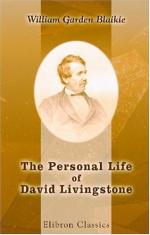And here he remained in his hut for eighty days, till 10th October, exercising patience, harrowed by the wickedness he could not stop, extracting information from the natives, thinking about the fountains of the Nile, trying to do some good among the people, listening to accounts of soko-hunting, and last, not least, reading his Bible. He did not leave Bambarre till 16th February, 1871. From what he had seen and what he had heard he was more and more persuaded that he was among the true fountains of the Nile. His reverence for the Bible gave that river a sacred character, and to throw light on its origin seemed a kind of religious act. He admits, however, that he is not quite certain about it, though he does not see how he can be mistaken. He dreams that in his early life Moses may have been in these parts, and if he should only discover any confirmation of sacred history or sacred chronology he would not grudge all the toil and hardship, the pain and hunger, he had undergone. The very spot where the fountains are to be found becomes defined in his mind. He even drafts a despatch which he hopes to write, saying that the fountains are within a quarter of a mile of each other!
Then he bethinks him of his friends who have done noble battle with slavery, and half in fancy, half in earnest, attaches their names to the various waters. The fountain of the Liambai or Upper Zambesi he names Palmerston Fountain, in fond remembrance of that good man’s long and unwearied labor for the abolition of the slave-trade. The lake formed by the Lufira is to be Lincoln Lake, in gratitude to him who gave freedom to four millions of slaves. The fountain of Lufira is associated with Sir Bartle Frere, who accomplished the grand work of abolishing slavery in Sindia, in Upper India. The central Lualaba is called the River Webb, after the warm-hearted friend under whose roof he wrote The Zambesi and its Tributaries; while the western branch is named the Young River, to commemorate his early instructor in chemistry and life-long friend, James Young. “He has shed pure white light in many lowly cottages and in some rich palaces. I, too, have shed light of another kind, and am fain to believe that I have performed a small part in the grand revolution which our Maker has been for ages carrying on, by multitudes of conscious and many unconscious agents, all over the world[69].”
[Footnote 69: See Last Journals. vol. ii. pp 65, 66.]
He is by no means unaware that death may be in the cup. But, fortified as he was by an unalterable conviction that he was in the line of duty, the thought of death had no influence to turn him either to the right hand or to the left. For the first three years he had a strong presentiment that he would fall. But it had passed away as he came near the end, and now he prayed God that when he retired it might be to his native home.




